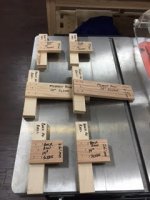Tim Brennan
Member
- Joined
- Jul 28, 2013
- Messages
- 146
So I am trying to cut strips of MDF with my TS55 REQ and have run into a snag that I have met dozens of times before. I am trying to get an accurate cut but setting up the track each time is time consuming and the track or workpiece sometimes slip because it is not supported adequately/needs extra clamps which slows things down even more.
I don't have the parallel guides and right now can't justify the cost of them (£139).
I just saw the Parallel side fence - PA-TS 55 which is only £33.
Are there any other ways to create a way to repeatedly make accurate cuts using pieces of timber or are there any other tips on this task? How does the side fence compare to the parallel guides?





I don't have the parallel guides and right now can't justify the cost of them (£139).
I just saw the Parallel side fence - PA-TS 55 which is only £33.
Are there any other ways to create a way to repeatedly make accurate cuts using pieces of timber or are there any other tips on this task? How does the side fence compare to the parallel guides?








